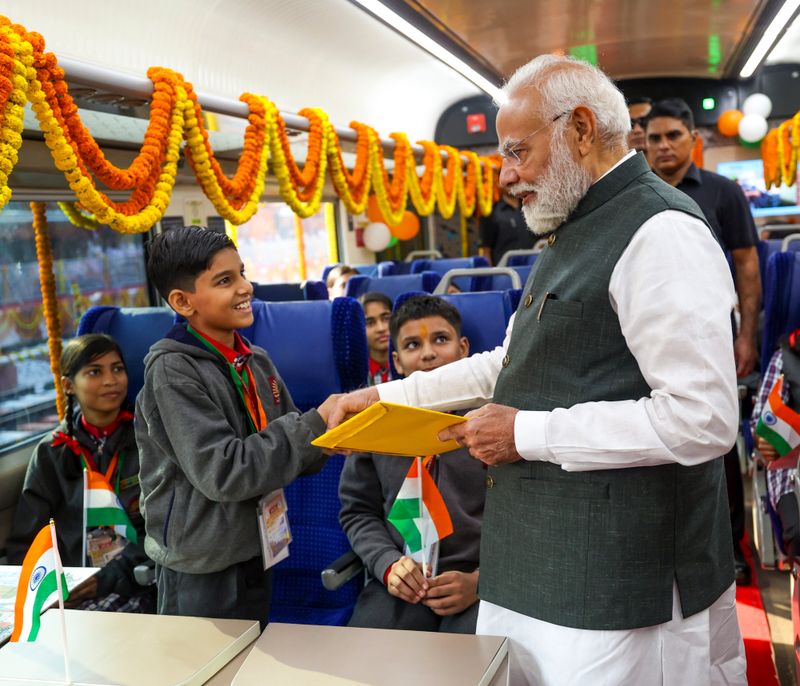
Prime Minister Narendra Modi on Saturday inaugurated four new Vande Bharat Express trains, marking a significant expansion in India’s next-generation railway network. The launch took place virtually from Varanasi, Modi’s parliamentary constituency, and included the Ferozepur-Delhi train, which is Punjab’s first Vande Bharat service for the Malwa region. Other routes include Varanasi-Khajuraho, Lucknow-Saharanpur, and Ernakulam-Bengaluru, connecting vital heritage, religious, and economic hubs across the country.
The event, held at Banaras railway station, saw the presence of Uttar Pradesh Chief Minister Yogi Adityanath and Union Railway Minister Ashwini Vaishnaw. Meanwhile, in Ferozepur, Union Minister of State for Railways Ravneet Singh Bittu led the ceremony for the Ferozepur-Delhi service, joined by Punjab BJP working president Ashwani Sharma and other local leaders. The train was warmly received at Ambala Cantt station by Haryana minister Anil Vij, who greeted passengers with roses.
Strategic Connectivity and Economic Impact
Addressing the gathering, Prime Minister Modi emphasized the transformative role of infrastructure in national development. He stated, “Infrastructure has played an important role in the development of most nations. The development of a city begins on its own as soon as it gets better connectivity.”
Highlighting the significance of the new trains, Modi remarked, “Trains like Vande Bharat, Namo Bharat, and Amrit Bharat are laying the foundation for the next-generation of the Indian Railways.” He further noted that these trains symbolize India’s rapid progress in rail infrastructure, often astonishing foreign visitors.
“India has embarked on a mission to enhance its resources for a developed India, and these trains are poised to become milestones in that journey,” the PM said.
The new services are expected to enhance regional mobility, promote tourism, and support economic activity. According to the Railway Ministry, the Vande Bharat trains will significantly reduce travel times across the new routes, including a reduction of 2 hours and 40 minutes on the Varanasi-Khajuraho route.
Political and Cultural Significance
The introduction of these trains also holds political significance, particularly for the Bharatiya Janata Party (BJP). The Ferozepur-Delhi route represents a strategic move in Punjab’s Malwa region, a contested political area. Bittu described the service as “a boost to trade and connectivity for the Malwa region.”
The Varanasi-Khajuraho route connects Modi’s constituency with the Bundelkhand region, while the Lucknow-Saharanpur train enhances access to Haridwar. In the south, the Ernakulam-Bengaluru service links major IT and trade hubs across Kerala, Tamil Nadu, and Karnataka.
Boosting Religious Tourism
Prime Minister Modi also underscored the economic impact of religious tourism, noting the significant contributions of pilgrims to local economies. Last year, 11 crore devotees visited Varanasi, while over six crore visited the Lord Ram temple in Ayodhya, contributing thousands of crores to Uttar Pradesh’s economy.
“These holy sites are now being connected through the Vande Bharat network. It’s a step towards transforming heritage cities into symbols of national progress,” Modi said.
“We want every visitor to experience a unique energy and joy in the sacred city of Baba Vishwanath,” he added.
Furthermore, Modi highlighted ongoing projects in Varanasi, such as new hospitals, roads, and improved connectivity, which are part of the broader vision of a “developed India” starting with a “developed Varanasi.”
Future Prospects and Youth Engagement
As India continues to expand its railway network, the Vande Bharat Express trains are set to play a crucial role in enhancing connectivity and fostering economic growth. The government’s focus on infrastructure development is expected to drive significant changes in regional mobility and tourism.
During the event, Modi also interacted with students who participated in a competition, praising their creative expressions on the themes of “Viksit Bharat” and “Viksit Kashi.” He suggested organizing a children’s literary meet to further encourage young talent.
The launch of these new trains marks a pivotal moment in India’s railway history, promising to bridge distances and bring communities closer together, while also supporting the nation’s economic and cultural aspirations.





